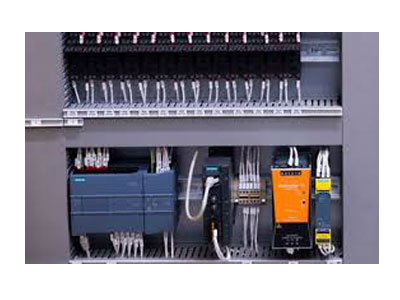How Do Control Panels Work In Industrial Systems?
Key Takeaway
Control panels in industrial systems serve as the central interface for managing and monitoring electrical and mechanical operations. They integrate components such as switches, relays, transformers, indicators, circuit breakers, and sensors to control and automate complex processes. Operators interact with the control panel to turn systems on or off, adjust settings, and receive real-time feedback on parameters like temperature, speed, and pressure. Relays control larger electrical loads using smaller input signals, while circuit breakers protect the system by interrupting power in cases of overloads or short circuits. Transformers adjust voltage levels as needed, and sensors provide data that triggers further actions.
The components are housed within enclosures made of materials like metal, plastic, or fiberglass, which shield them from environmental factors such as dust, moisture, and temperature fluctuations. Control panels contribute significantly to operational efficiency by reducing downtime and repair costs, improving safety, and allowing better control of industrial equipment. The integration of actuators converts control signals into physical actions, such as opening or closing valves, and power supplies ensure the correct voltage is supplied to the system. Overall, these panels are vital for the streamlined and safe functioning of industrial operations.
Functional Overview of Control Panels
Control panels act as central command stations that house various components responsible for the operation of industrial machinery and systems. They serve as the main interface for operators to control, monitor, and manage equipment. Typically, control panels include electrical switches, relays, circuit breakers, and power distribution devices. These panels are designed to house and protect the wiring and other electrical components, ensuring safe and reliable operation.
The primary function of control panels is to send and receive electrical signals to and from connected equipment. These signals allow the control panel to activate or deactivate machines, adjust operational parameters, and ensure that the system operates within its specified range. In addition, control panels provide operators with a visual interface, such as meters and indicators, to track the system’s status in real time.

Signal Processing and Communication
One of the critical functions of control panels is signal processing, which involves receiving, interpreting, and transmitting electrical signals. These signals can be either analog or digital and are used to monitor system parameters like temperature, pressure, and flow rate. Control panels often incorporate sensors that gather data from the industrial process and transmit it to the central controller. This data is processed and used to make decisions or trigger specific actions, such as shutting down a machine when an abnormal condition is detected.
Communication within control panels is facilitated by programmable logic controllers (PLCs) and human-machine interfaces (HMIs). PLCs are responsible for processing the signals and executing pre-defined logic, while HMIs provide operators with a user-friendly interface to view data, adjust settings, and manage operations remotely. The communication between these components is crucial for seamless operation and effective process control, ensuring that all systems are synchronized and functioning optimally.
Real-Time Monitoring and Feedback Mechanisms
Control panels are designed to provide real-time monitoring of industrial processes, which is vital for maintaining optimal performance and preventing failures. Equipped with a range of instruments, such as voltmeters, ammeters, and pressure gauges, control panels allow operators to track system performance at a glance. Visual indicators and alarms alert operators when parameters exceed safe limits or when faults are detected, enabling quick corrective action to be taken.
Feedback mechanisms play a significant role in maintaining system stability. For instance, if a sensor detects an increase in temperature beyond the set threshold, the control panel will receive this feedback and activate a cooling system or shut down the equipment to prevent damage. This closed-loop system ensures that operations remain within safe parameters, minimizing the risk of accidents and equipment damage.
Automation and Energy Efficiency
Control panels are pivotal for automating industrial processes, which can significantly improve efficiency and reduce operational costs. Through the use of PLCs, control panels can execute complex sequences and adapt to changes in the system without human intervention. This automation leads to faster and more accurate execution of tasks, better resource management, and increased productivity.
Moreover, control panels contribute to energy efficiency by optimizing operations and reducing waste. For example, variable frequency drives (VFDs) integrated into control panels can adjust motor speeds based on demand, lowering energy consumption. This helps industries not only save on energy costs but also supports environmental sustainability by reducing carbon emissions.
Examples of Industrial Applications
Control panels are used in a wide range of industrial applications, from manufacturing plants and process control facilities to energy distribution and water treatment plants. In manufacturing, control panels help automate production lines, ensuring that machines operate at optimal speeds and in sync with each other. In power plants, control panels manage the distribution of electricity, monitor generator status, and control circuit breakers for safe operation.
In water treatment plants, control panels regulate the flow of water, monitor chemical levels, and ensure that treatment processes are functioning correctly. In transportation systems, control panels are used for managing traffic lights, monitoring train signals, and controlling the movement of automated systems in airports and ports.
Conclusion
Control panels play an integral role in industrial systems, providing a centralized point for control, monitoring, and communication. They ensure safe operation, real-time monitoring, and effective automation, which boosts efficiency and productivity. By integrating advanced technologies such as PLCs and HMIs, control panels can handle complex industrial processes, leading to better resource management and energy efficiency. Whether it’s manufacturing, power generation, or water treatment, the significance of control panels in streamlining operations cannot be overstated.

